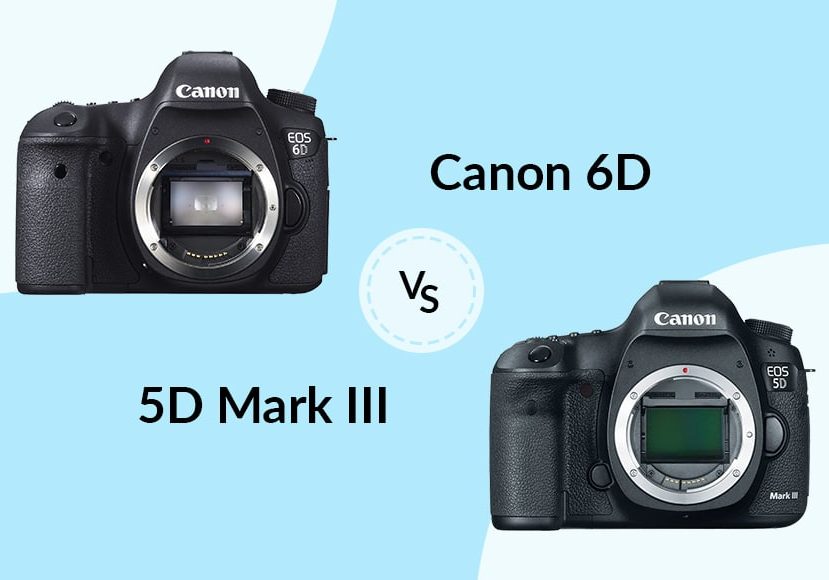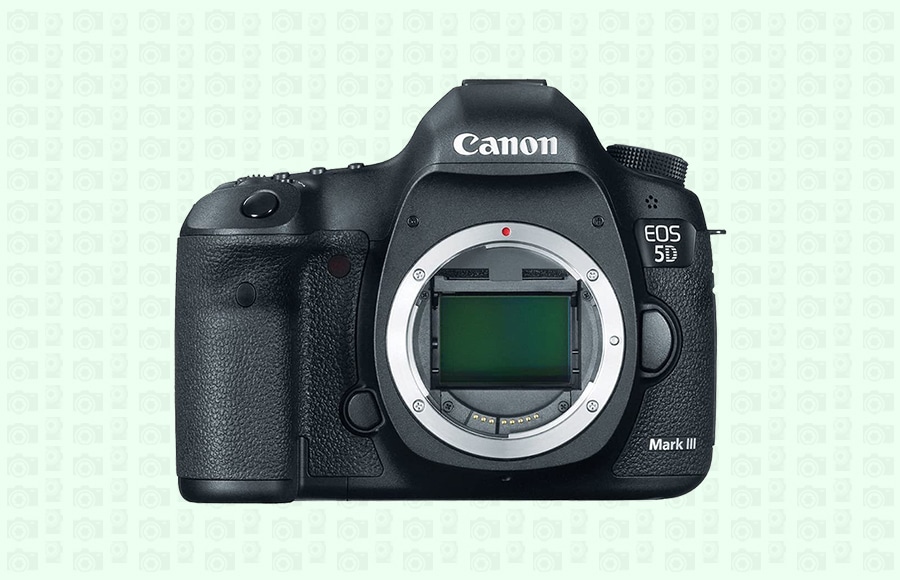
Canon 6D vs 5D Mark III
Which should you buy: the Canon 6D or the 5D Mark III? Find out as we compare 2 hugely popular DSLRs and help you decide which is best for you in 2023!
This Canon 6D vs 5D Mark III guide is exactly what you need if you’re struggling to choose between these two excellent full-frame cameras.
I’m going to tell you everything you should know about these two DSLRs – so that you can make an informed decision about which is best for your photography.

Sturdy, reliable camera that stands the test of time and makes for an excellent entry point into the full-frame DSLR market.
The Canon 5D Mark III is the older of the two models, but don’t let that fool you. It packs quite a punch in terms of its build, full-frame image quality, and autofocus performance, even after the better part of a decade.
But while the Canon 6D may not have quite as many megapixels or AF points, it’s still an excellent option for photographers looking to enter into the full-frame arena without significant bulk (or cost).
To discover all the key differences between these two cameras, read on!
Canon 6D vs 5D Mark III | Key Differences
1. Size & Weight
The Canon EOS 6D and the Canon EOS 5D Mark III are both full-frame DSLRs, but while the 5D is designed as a rugged, professional camera, Canon really managed to cut down on size and weight for the 6D.
The EOS 6D is both surprisingly small and surprisingly light. It clocks in at 770 g (27 oz), nearly 200 g lighter than the 5D Mark III (at 950 g/33.5 oz).
And while its dimensions don’t stray far from the 5D Mark III’s, the 6D’s build is slimmer overall: 145 x 111 x 71mm, versus 152 x 116.4 x 76.4mm.
In other words, the 6D is a few millimeters shorter, a few millimeters thinner, and offers a slightly smaller grip, making it the better option for travel photographers, street photographers, or more casual photographers who are still looking for that full-frame image quality.
Now, the EOS 5D Mark III isn’t Canon’s largest DSLR, and it won’t feel too massive, even next to the compact 6D. But there is a noticeable difference, and it’s one that’ll matter if you do a lot of traveling, or if you work frequently with smaller lenses. In this part of the Canon 5D vs 6D comparison, the 6D wins ever so slightly.
2. Build & Handling
When it comes to build quality, both the 6D and the 5D Mark III feel quite solid, though the latter does offer a more rugged body overall.
The 6D has weather sealing, and I’d feel comfortable taking it out in light rain or snow (and heavier conditions with a rain cover). In fact, I used the 6D for years in fairly adverse conditions, and it held up just fine.
As for the 5D Mark III, it feels like a professional body, which comes from excellent weather sealing and magnesium alloy construction.
In terms of ergonomics, both cameras fit quite nicely in the hand. The 6D’s smaller and lighter body may feel more comfortable on long shoots, but you do get a bigger front grip on the 5D Mark III as well as a dedicated joystick.
A point in favor of the 6D is its connectivity options: You get built-in wi-fi, as well as built-in GPS. While wi-fi and GPS can be achieved on the 5D, you’ll have to purchase additional equipment.
On the other hand, the 6D only has one card slot (SD), versus two on the 5D Mark III (1 SD, 1 CF).
For more serious shooters looking to use your camera as a wedding photography backup, or anyone trying to break into fast-paced professional photography, this is going to be a huge deal – and it’s one of the reasons why the 5D Mark III was labeled as a “professional” camera upon its release.
3. Rear LCD & Optical Viewfinders
Both these cameras debuted in 2012, which means that they’re lacking more sophisticated rear LCD features (such as touch screens).
But both LCDs are quite nice for what they are: fixed in place, but crisp and clear, good for focusing and reviewing images alike.
Though LCD resolutions are identical, you do get a bit more real-estate on the Canon EOS 5D Mark III, at 3.2 inches (versus 3 inches on the EOS 6D). While this isn’t a huge difference, the bigger the screen the better, especially for anyone who frequently shoots with the LCD.
In terms of viewfinders, you get 100% coverage on the 5D Mark III, compared to 97% on the 6D. I very much dislike using cropped viewfinders – it’s too easy for annoying elements to creep into the edges of the frame – but if you’re used to using a camera with incomplete viewfinder coverage, then this may not be much of an inconvenience. In this category of the canon 5D Mark III vs 6D, the 5D Mark III is the winner.
4. Autofocus
Take a look at the autofocus systems on both these cameras, and you’ll immediately notice some huge differences:
The Canon EOS 5D Mark III offers 61 AF points, 41 of them cross-type. You also get decent (though hardly frame-filling) autofocus coverage, which is going to significantly improve tracking and AF efficiency.
The Canon 6D, on the other hand, only packs 11 autofocus points, clustered around the center of the frame. And just one of them (the center point) is cross-type.
All in all, this makes for a decent AF performance from the 5D Mark III when using the viewfinder. While it’s not on the same level as today’s top-level bodies, you’re going to get fast, consistent focusing, even when working with moving subjects.
But things do slow down significantly when working in Live View – here, you’ll have to resign yourself to some very ponderous focusing, or you’ll want to skip Live View shooting entirely.
The 6D, on the other hand, is a poor AF performer across the board. The 11 autofocus points don’t offer much in the way of tracking, though you can nail still subjects pretty fast (as long as you’re okay with focus-and-recompose techniques).
So if you’re a budding sports or action shooter, go with the 5D Mark III.
5. Drive
You’ll find a similar story here:
A 6 fps continuous shooting speed on the Canon EOS 5D Mark III, compared to a 4.5 fps continuous shooting speed on the Canon EOS 6D.
Honestly, neither of these is great for sports, wildlife, or street photography – but you’ll be able to make do with the Canon 5D Mark III. The 6D, on the other hand, is just too slow for serious action shooting.
Neither buffer is ultra-impressive, but the 5D has a slight edge here, as well: 18 RAW photos or 16270 JPEGs, versus 17 RAW photos or 1250 JPEGs on the Canon 6D.
6. Image Quality

Credit: Mark Condon
The Canon EOS 5D Mark III and the Canon EOS 6D are both full-frame cameras, which means that you can expect generally strong high-ISO performance across the board from both bodies.
While I’d give the Canon 6D a slight edge in terms of high-ISO noise performance, it’s a close call. And I can really only tell the difference between RAW files when zoomed in to 100%.
On the 5D Mark III, noise starts to creep in at around ISO 1600, becoming more apparent at ISO 3200 and becoming unusable around ISO 12800 (though the latter judgment depends heavily on your intentions).
The 6D is similar, though it shows less noise at ISO 1600. I’d feel comfortable pushing ISO to 6400, but after that things start to look a bit iffy.
Note that the 6D does have a slightly smaller pixel count, which contributes to this slight difference in noise: 20 megapixels versus 22.3 megapixels.
But while this resolution difference matters slightly in terms of image quality, you’re not going to notice much in terms of increased cropping capabilities from the 5D Mark III; two megapixels just isn’t going to get you much of a boost.
In terms of dynamic range, both these cameras are pretty disappointing, offering about 12 stops at a maximum (11.7 on the 5D Mark III, 12.1 on the 6D). Canon isn’t the best manufacturer when it comes to DR, but a number of its more recent bodies can crush the 6D or the 5D Mark III, including the 5D Mark IV and the Canon EOS R.
To sum up:
If you’re a frequent low-light shooter, both of these cameras are going to be more than adequate. The 6D is better by a hair, but you may not notice a difference in practice.
In terms of dynamic range and megapixels, differences are too subtle to be significant, with the Canon 5D Mark III slightly ahead on resolution and slightly behind on dynamic range.
7. Video
If you’re looking to shoot video along with stills, then both of these cameras are going to be pretty equal – and far from impressive.
The Canon 6D and the Canon 5D Mark III both offer 1080p shooting at 30 frames per second. This isn’t up to current standards, where many cameras offer 4K/30p shooting.
And even older DSLRs tend to feature at least full HD at 60p.
You do get a microphone jack on both cameras, though only the 5D Mark III packs a headphone port.
While you can record HD video on either one of these models, there are plenty of other options on the market that will allow for far better video (and at a decent price, too).
8. Price
You’re going to struggle to find either of these cameras new – but used, they’re both available for bargain prices.
And that is why they’re both great first full-frame options for enthusiasts.
The 6D is slightly cheaper than the 5D Mark III, at around US$500-$550. But the 5D Mark III is only US$800-$850 or so, which is an excellent price for a camera offering so many excellent features.
(The original retail prices, by the way, reflected this difference. You could grab the 5D Mark III for around $2,800, compared to $2,099 for the 6D.)
In many ways, the 5D Mark III is the better camera.
So the real question is:
Are you willing to pay an extra $300 for it?
Canon 6D vs 5D Mark III | Final Words

Canon 6D | Credit: Mark Condon
The Canon EOS 6D and the Canon EOS 5D Mark III are both excellent cameras, even if they have been succeeded by more powerful (albeit pricier) options.
Remember that while both bodies offer comparable image quality, the 5D Mark III packs significantly better autofocus, slightly better build quality, a 100%-coverage viewfinder, and dual card slots.
On the other hand, the 6D is smaller and lighter, plus it offers built-in wi-fi and GPS.
Ultimately, the choice is yours – and will depend on what you want to shoot. If you’re thinking of dabbling in any action-related photography (street, sports, wildlife, bird) then go with the 5D Mark III. It’s worth the extra money.
If you’re planning on shooting any fast-paced events where redundancy is important, then you should also go with the 5D Mark III. The dual card slots are going to be key.
But if you want great image quality in a smaller package and are looking for a great camera for travel photography, casual everyday photography, or even landscape photography – then the 6D is a great buy.

Sturdy, reliable camera that stands the test of time and makes for an excellent entry point into the full-frame DSLR market.












